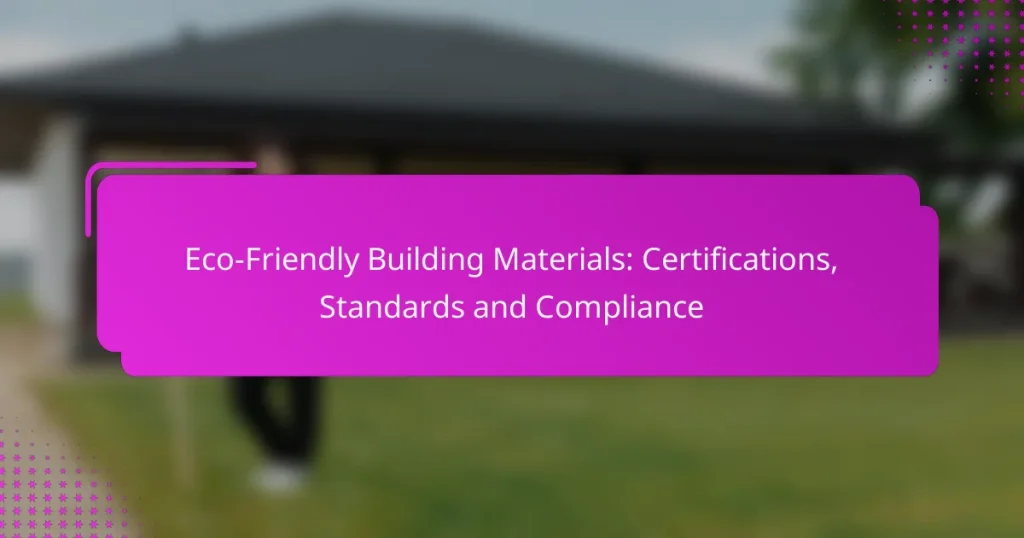Eco-friendly building materials are designed to minimize environmental impact throughout their lifecycle, from sourcing to disposal. Various certifications and standards exist to guide consumers and builders in selecting sustainable options that prioritize energy efficiency and reduce pollution. Compliance with these regulations ensures that materials meet specific ecological criteria, promoting a healthier and more sustainable built environment.

What are eco-friendly building materials?
Eco-friendly building materials are sustainable options that minimize environmental impact during their lifecycle. They are sourced, manufactured, and disposed of in ways that reduce pollution, conserve resources, and promote health and safety.
Recycled materials
Recycled materials are products made from previously used materials, reducing waste and the need for new resources. Common examples include recycled steel, glass, and concrete, which can be repurposed in construction projects.
When using recycled materials, ensure they meet local building codes and standards. Look for certifications that confirm their quality and sustainability, such as the Cradle to Cradle certification.
Bamboo
Bamboo is a fast-growing grass that serves as a strong, lightweight building material. Its rapid growth cycle makes it a renewable resource, often harvested in three to five years compared to decades for traditional timber.
Consider using bamboo for flooring, cabinetry, or structural elements. Ensure it is treated properly to resist pests and moisture, and check for certifications like FSC (Forest Stewardship Council) to guarantee sustainable sourcing.
Hempcrete
Hempcrete is a biocomposite made from hemp hurds and lime, providing excellent insulation and a low carbon footprint. It is not load-bearing but is often used in combination with other materials to create energy-efficient walls.
When considering hempcrete, be aware of its moisture management properties and ensure it is applied correctly to maximize its benefits. Look for suppliers that adhere to local building regulations and standards for hemp-based products.
Reclaimed wood
Reclaimed wood is salvaged from old buildings, furniture, or other structures, giving it a second life while reducing deforestation. This material often has unique character and history, making it desirable for aesthetic purposes.
When using reclaimed wood, inspect it for structural integrity and potential contaminants. Verify that it complies with local building codes and consider treatments to enhance durability and resistance to pests.
Low-VOC paints
Low-VOC (volatile organic compounds) paints are formulated to emit fewer harmful chemicals into the air, promoting better indoor air quality. These paints are essential for eco-friendly building practices, especially in residential spaces.
When selecting low-VOC paints, check for certifications like Green Seal or the EPA’s Safer Choice label. Always ensure proper ventilation during application and drying to further minimize any potential health risks.

What certifications are available for eco-friendly building materials?
Several certifications exist for eco-friendly building materials, each focusing on sustainability, energy efficiency, and environmental impact. These certifications help consumers and builders identify products that meet specific ecological standards.
LEED certification
LEED (Leadership in Energy and Environmental Design) certification is a globally recognized symbol of sustainability achievement. It evaluates buildings based on criteria such as energy use, water efficiency, and materials selection, awarding points that lead to different certification levels: Certified, Silver, Gold, and Platinum.
To achieve LEED certification, projects must meet prerequisites and earn points across various categories. For example, using recycled materials or implementing energy-efficient systems can significantly boost a project’s score. Builders should consider the costs associated with certification, which can vary widely based on project size and complexity.
Green Seal certification
Green Seal certification focuses on products’ environmental impact, ensuring they meet rigorous sustainability standards. This certification covers a wide range of products, including paints, cleaning supplies, and building materials, promoting safer, healthier options for consumers.
To obtain Green Seal certification, manufacturers must demonstrate compliance with specific criteria, such as reduced toxicity and resource conservation. This certification can enhance a product’s marketability, as consumers increasingly seek eco-friendly options. Companies should be aware of the certification process, which involves documentation and potential testing fees.
Energy Star certification
Energy Star certification is primarily associated with energy efficiency in appliances and building materials. Products that earn this label meet strict energy performance standards set by the U.S. Environmental Protection Agency (EPA), helping consumers save on energy costs while reducing greenhouse gas emissions.
For building materials, Energy Star certification indicates that they contribute to overall energy efficiency in a structure. For instance, windows and insulation with this certification can significantly lower heating and cooling costs. Builders should consider incorporating Energy Star products to enhance the energy performance of their projects and appeal to environmentally conscious clients.

How do building materials comply with environmental standards?
Building materials comply with environmental standards through a series of certifications and regulations that ensure they meet specific sustainability criteria. These standards assess factors such as resource efficiency, emissions, and overall environmental impact, guiding manufacturers and builders in selecting eco-friendly options.
ISO 14001 standards
ISO 14001 is an international standard that outlines the requirements for an effective environmental management system (EMS). Organizations that adopt this standard commit to continuous improvement in their environmental performance, which includes managing waste, reducing emissions, and conserving resources.
To comply with ISO 14001, companies must establish an EMS that includes planning, implementation, evaluation, and review processes. This often involves conducting regular audits and assessments to ensure adherence to environmental policies and objectives.
ASTM standards
ASTM standards are developed by the American Society for Testing and Materials and provide guidelines for the quality and performance of building materials. These standards cover a wide range of products, including concrete, steel, and insulation, ensuring they meet safety and environmental requirements.
Compliance with ASTM standards typically involves rigorous testing and certification processes. For example, materials may need to demonstrate low volatile organic compound (VOC) emissions or high recyclability to qualify for specific green building certifications.

What are the benefits of using eco-friendly building materials in urban areas?
Using eco-friendly building materials in urban areas offers significant advantages, including reduced environmental impact and enhanced quality of life. These materials contribute to sustainable development by minimizing resource depletion and improving the health of inhabitants.
Reduced carbon footprint
Eco-friendly building materials typically have a lower carbon footprint compared to conventional options. Materials such as bamboo, recycled steel, and reclaimed wood require less energy to produce and transport, leading to decreased greenhouse gas emissions. Choosing locally sourced materials further reduces transportation emissions.
Consider using products certified by recognized standards, such as LEED or BREEAM, which emphasize sustainability and lower carbon outputs. Implementing these materials can significantly contribute to urban areas’ climate goals.
Improved indoor air quality
Eco-friendly materials often contain fewer volatile organic compounds (VOCs), which can negatively impact indoor air quality. By opting for low-VOC paints, finishes, and adhesives, you can create healthier living environments that reduce the risk of respiratory issues and allergies.
Additionally, materials like natural fibers and sustainably sourced wood can enhance air quality by regulating humidity and absorbing pollutants. Regularly ventilating spaces and using air-purifying plants can further improve indoor conditions.
Energy efficiency
Many eco-friendly building materials contribute to better energy efficiency in urban structures. Insulation made from recycled materials or natural fibers can reduce heating and cooling costs by maintaining stable indoor temperatures. This can lead to energy savings of 20-30% over time.
Incorporating energy-efficient windows and roofing materials can also minimize energy consumption. Look for products with Energy Star ratings or similar certifications to ensure optimal performance and compliance with energy regulations.

How to choose eco-friendly building materials for construction projects?
To choose eco-friendly building materials, prioritize options that minimize environmental impact throughout their lifecycle, from sourcing to disposal. Consider factors such as sustainability certifications, local availability, and the materials’ energy efficiency.
Assess material lifecycle
Evaluating the lifecycle of building materials involves examining their production, use, and end-of-life stages. Look for materials that are renewable, recyclable, or biodegradable, which can significantly reduce waste and resource depletion. For example, bamboo and reclaimed wood are excellent choices due to their rapid renewability and low environmental impact.
Consider the energy consumption associated with the manufacturing and transportation of materials. Opt for products with low embodied energy, which refers to the total energy required to extract, process, and transport them. This can often be assessed through certifications like LEED or BREEAM.
Evaluate local sourcing options
Local sourcing of building materials can greatly reduce transportation emissions and support the regional economy. Identify suppliers within a reasonable distance to minimize the carbon footprint associated with shipping. Materials like locally sourced stone, timber, or clay can often be more sustainable than imported alternatives.
Additionally, check for local regulations or incentives that promote the use of sustainable materials. Many regions offer tax benefits or grants for projects that utilize eco-friendly products, which can help offset initial costs. Always verify the sustainability claims of local suppliers to ensure compliance with recognized standards.


